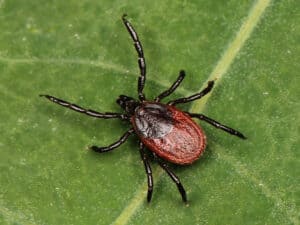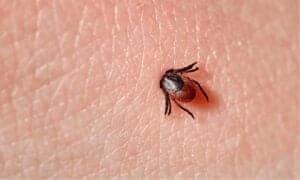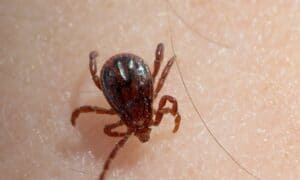What Kills Ticks On A Dog Instantly?
@media (min-width: 481px) {
.mobile-top-content {
display: none;
}
}
#mobileTopContentCTACarouselControls { overflow: hidden; text-overflow: ellipsis; white-space: nowrap; }
.mobile-top-content .more { color: #fff; }
.mobile-top-content a { color: #fff; text-decoration: underline; }
.mobile-top-content a:hover { color: #fff; text-decoration: underline; }
@media (max-width: 480px) {
.mobile-top-content {
background-color: #06a10b;
color: #fff;
text-align: center;
/*height: 60px;
padding-top:5px;*/
font-size:80%;
/* display: block; */
margin: 0px -30px;
}
}
Dogs are one of life’s greatest rewards, but caring for a pet dog comes with its share of downsides. One of the more revolting of these downsides is having to remove a tick, or worse, multiple ticks, from your dog! The concept is so gross that we are willing to bet that is why you are here! So, what kills ticks on a dog instantly?
Most experts agree that removing the tick before trying to kill it is best. It is important to know the correct method for removing a tick from your dog, as well as how to dispose of it. Also, it is crucial to know how to prevent your dog from picking up a tick, as well as which products kill both ticks and the eggs.
How To Remove And Kill Ticks On A Dog Instantly
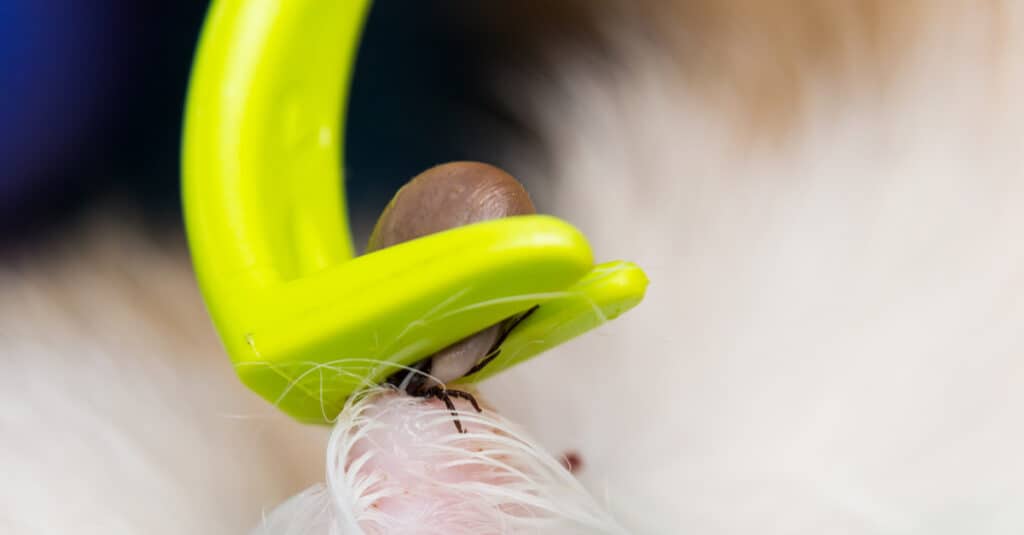
Todorean-Gabriel/Shutterstock.com
If you notice one or more ticks already attached to your dog, physically removing the tick is recommended. Submerging a tick in original Listerine or rubbing alcohol will kill it instantly. However, applying these substances may kill the tick, but it will stay attached to your dog’s skin. It is important to know that dogs are susceptible to dangerous species like deer ticks, American dog ticks, and wood ticks and can get the same life-threatening diseases we can. Also, we cannot forget the much-loathed dog tick or its indoor-loving cousin, the brown dog tick!
Best Practices To Remove A Tick From Your Dog
To safely remove a tick from your dog, follow the steps below:
- Using clean, fine-tipped tweezers, grip the tick close to the dog’s skin.
- Using steady pressure, gently pull the tick in a straight upward motion.
- Do not twist, jerk, or squeeze the tick when pulling it from the skin. This may leave the head embedded, which is harder to remove from a dog’s skin or fur.
- If the head becomes detached, use the tweezers to remove it carefully.
- If the mouthparts do not come out, leave them to come out naturally.
- Thoroughly clean the affected area and your hands with alcohol or soap and water.
- To kill the tick if it is alive when removed, use alcohol or original amber-colored Listerine, place it in a sealed plastic bag or container, seal it in adhesive tape, or flush the tick down the toilet.
It is important to keep in mind that many home remedies do not work. More importantly, some remedies may even be harmful or dangerous to your dog or your other pets. For example, some natural remedies may be safe for your dog but prove toxic to your cats! Additionally, some at-home remedies are worse than unsafe; they are plain dangerous.
The following home remedies are not recommended for use to kill a tick on your dog:
- Nail polish
- Dish soap
- Essential oils
- Flammable materials like gasoline
- Fire, flame, or high heat
- Corrosive chemicals like bleach
We cannot stress enough that the use of fire, flame, or highly combustible materials should not be used to kill any tick. Additionally, many of these products may be unsafe for your dog due to ingestion. Do not use any type of chemical or product on your dog unless a trusted veterinarian approves it.
When To Take Your Dog To The Veterinarian
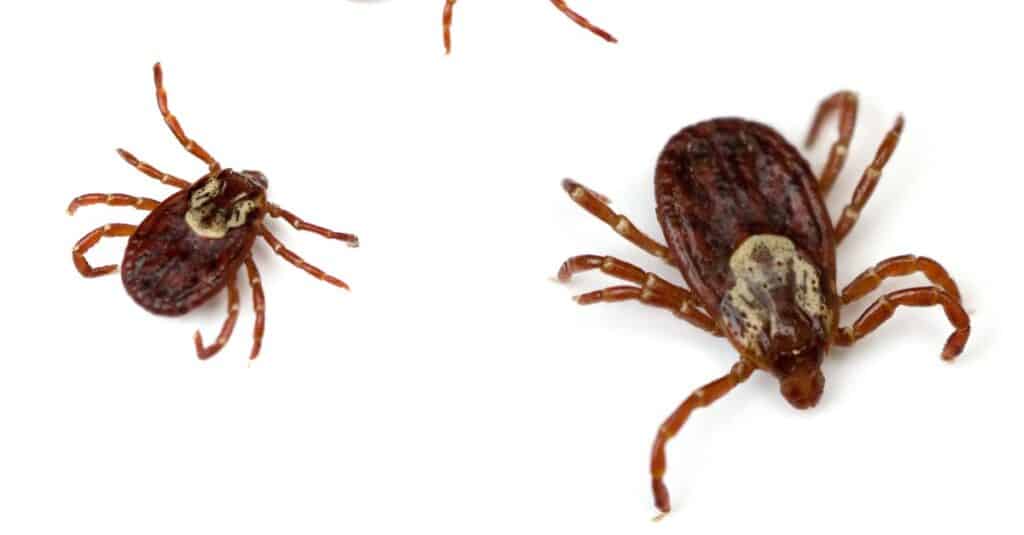
iStock.com/epantha
There are occasions when you should take your dog to the vet to remove ticks instead of removing them yourself. Additionally, some species of ticks can transmit serious diseases to your dog. Also, a full-blown tick infestation is a life-threatening condition for any pet. This is true for both adult dogs and puppies. We strongly urge you to take any pet with multiple ticks to the vet as soon as possible.
You should take your dog to the vet when:
- Your dog has more than a few ticks. Only a professional veterinarian should handle a large tick infestation. Attempting to remove many ticks may harm your dog, and multiple ticks may require additional medical care!
- There is reddened skin near or around the bite
- There are fever symptoms, rashes, or listlessness
- There are other symptoms of illness.
Remember, your vet is your best and most trusted source for getting to the bottom of any health concerns. Even the smallest symptom of illness regarding a tick bite should be discussed with your vet. A trip to the vet is especially crucial when dealing with many ticks. Remember, ticks are blood-sucking parasites!
Products Available That Kill Ticks On Dogs

Chutima Chaochaiya/Shutterstock.com
Many products are commercially available that can not only kill adult ticks on your dog but their eggs as well. This often has the added benefit of killing ticks on surfaces your dog encounters as well. You can also take steps to eliminate ticks on yourself and your yard, too!
Commercial tick and flea products include:
- Spot treatments like Frontline that you apply monthly to kill ticks and fleas.
- Oral medications that work monthly to kill ticks and fleas without exposure to the medication via the dog’s skin.
- Flea and tick shampoos for dogs that instantly kill any ticks present on your dog for up to two weeks.
- Tick dips that stay on the skin and fur. This method is not advisable for dogs under four months old, pregnant dogs, or nursing dogs.
- Tick collars that protect the head and neck of your pet. This method will not necessarily prevent ticks on the body.
- Tick powders and sprays made for dogs that kill ticks instantly and last for up to one week.
Remember, always make sure any product or chemical you use on your dog is vet-approved and safe! For more on how to deal with ticks, check out our articles on where ticks live, how long ticks live, and what ticks look like!
Unsafe Tick Removal Methods That Could Harm Your Dog
While there is a lot of information online about how to remove pests like ticks and fleas from your dog, some methods are just unsafe. Both commercial products and home remedies may pose a serious risk to your dog! Remember, always consult your vet before using any flea and tick removal method on your dog. You can also check out our top picks for flea and tick treatment for dogs.
Substances that are known to cause harmful effects on dogs are:
- Prominent levels of permethrin
- Essential oils like clove or cinnamon. These can cause stomach problems, gagging, drooling, foaming at the mouth, skin irritation, lethargy, or liver damage.
- Any product meant for human use or use for other pets or livestock
Additionally, products like dish soap or vinegar have little to no effect on either killing or preventing ticks on a dog. While many home remedies sing the praises of using these products, none of them have been proven to work.
Using A New Product For Fleas And Ticks On Your Dog
To find commercial products that are safe for your dog, read labels carefully and look for EPA-approved or FDA-registered products. Also, monitor your dog closely when using a new product. If you notice any signs of distress or illness, stop using the product and call your vet!
Ticks are an unfortunate part of owning a dog, but the issue does not have to be completely horrible. While prevention is key, knowing what to do if your furry friend gets a tick is just one more way to show you love them!
More from A-Z Animals
.more-snake-card-image { max-height:140px !important; }
@media (min-width: 481px) {
.mobile-top-content {
display: none;
}
}
#mobileTopContentCTACarouselControls { overflow: hidden; text-overflow: ellipsis; white-space: nowrap; }
.mobile-top-content .more { color: #fff; }
.mobile-top-content a { color: #fff; text-decoration: underline; }
.mobile-top-content a:hover { color: #fff; text-decoration: underline; }
@media (max-width: 480px) {
.mobile-top-content {
background-color: #06a10b;
color: #fff;
text-align: center;
/*height: 60px;
padding-top:5px;*/
font-size:80%;
/* display: block; */
margin: 0px -30px;
}
}
Dogs are one of life’s greatest rewards, but caring for a pet dog comes with its share of downsides. One of the more revolting of these downsides is having to remove a tick, or worse, multiple ticks, from your dog! The concept is so gross that we are willing to bet that is why you are here! So, what kills ticks on a dog instantly?
Most experts agree that removing the tick before trying to kill it is best. It is important to know the correct method for removing a tick from your dog, as well as how to dispose of it. Also, it is crucial to know how to prevent your dog from picking up a tick, as well as which products kill both ticks and the eggs.
How To Remove And Kill Ticks On A Dog Instantly

Todorean-Gabriel/Shutterstock.com
If you notice one or more ticks already attached to your dog, physically removing the tick is recommended. Submerging a tick in original Listerine or rubbing alcohol will kill it instantly. However, applying these substances may kill the tick, but it will stay attached to your dog’s skin. It is important to know that dogs are susceptible to dangerous species like deer ticks, American dog ticks, and wood ticks and can get the same life-threatening diseases we can. Also, we cannot forget the much-loathed dog tick or its indoor-loving cousin, the brown dog tick!
Best Practices To Remove A Tick From Your Dog
To safely remove a tick from your dog, follow the steps below:
- Using clean, fine-tipped tweezers, grip the tick close to the dog’s skin.
- Using steady pressure, gently pull the tick in a straight upward motion.
- Do not twist, jerk, or squeeze the tick when pulling it from the skin. This may leave the head embedded, which is harder to remove from a dog’s skin or fur.
- If the head becomes detached, use the tweezers to remove it carefully.
- If the mouthparts do not come out, leave them to come out naturally.
- Thoroughly clean the affected area and your hands with alcohol or soap and water.
- To kill the tick if it is alive when removed, use alcohol or original amber-colored Listerine, place it in a sealed plastic bag or container, seal it in adhesive tape, or flush the tick down the toilet.
It is important to keep in mind that many home remedies do not work. More importantly, some remedies may even be harmful or dangerous to your dog or your other pets. For example, some natural remedies may be safe for your dog but prove toxic to your cats! Additionally, some at-home remedies are worse than unsafe; they are plain dangerous.
The following home remedies are not recommended for use to kill a tick on your dog:
- Nail polish
- Dish soap
- Essential oils
- Flammable materials like gasoline
- Fire, flame, or high heat
- Corrosive chemicals like bleach
We cannot stress enough that the use of fire, flame, or highly combustible materials should not be used to kill any tick. Additionally, many of these products may be unsafe for your dog due to ingestion. Do not use any type of chemical or product on your dog unless a trusted veterinarian approves it.
When To Take Your Dog To The Veterinarian

iStock.com/epantha
There are occasions when you should take your dog to the vet to remove ticks instead of removing them yourself. Additionally, some species of ticks can transmit serious diseases to your dog. Also, a full-blown tick infestation is a life-threatening condition for any pet. This is true for both adult dogs and puppies. We strongly urge you to take any pet with multiple ticks to the vet as soon as possible.
You should take your dog to the vet when:
- Your dog has more than a few ticks. Only a professional veterinarian should handle a large tick infestation. Attempting to remove many ticks may harm your dog, and multiple ticks may require additional medical care!
- There is reddened skin near or around the bite
- There are fever symptoms, rashes, or listlessness
- There are other symptoms of illness.
Remember, your vet is your best and most trusted source for getting to the bottom of any health concerns. Even the smallest symptom of illness regarding a tick bite should be discussed with your vet. A trip to the vet is especially crucial when dealing with many ticks. Remember, ticks are blood-sucking parasites!
Products Available That Kill Ticks On Dogs

Chutima Chaochaiya/Shutterstock.com
Many products are commercially available that can not only kill adult ticks on your dog but their eggs as well. This often has the added benefit of killing ticks on surfaces your dog encounters as well. You can also take steps to eliminate ticks on yourself and your yard, too!
Commercial tick and flea products include:
- Spot treatments like Frontline that you apply monthly to kill ticks and fleas.
- Oral medications that work monthly to kill ticks and fleas without exposure to the medication via the dog’s skin.
- Flea and tick shampoos for dogs that instantly kill any ticks present on your dog for up to two weeks.
- Tick dips that stay on the skin and fur. This method is not advisable for dogs under four months old, pregnant dogs, or nursing dogs.
- Tick collars that protect the head and neck of your pet. This method will not necessarily prevent ticks on the body.
- Tick powders and sprays made for dogs that kill ticks instantly and last for up to one week.
Remember, always make sure any product or chemical you use on your dog is vet-approved and safe! For more on how to deal with ticks, check out our articles on where ticks live, how long ticks live, and what ticks look like!
Unsafe Tick Removal Methods That Could Harm Your Dog
While there is a lot of information online about how to remove pests like ticks and fleas from your dog, some methods are just unsafe. Both commercial products and home remedies may pose a serious risk to your dog! Remember, always consult your vet before using any flea and tick removal method on your dog. You can also check out our top picks for flea and tick treatment for dogs.
Substances that are known to cause harmful effects on dogs are:
- Prominent levels of permethrin
- Essential oils like clove or cinnamon. These can cause stomach problems, gagging, drooling, foaming at the mouth, skin irritation, lethargy, or liver damage.
- Any product meant for human use or use for other pets or livestock
Additionally, products like dish soap or vinegar have little to no effect on either killing or preventing ticks on a dog. While many home remedies sing the praises of using these products, none of them have been proven to work.
Using A New Product For Fleas And Ticks On Your Dog
To find commercial products that are safe for your dog, read labels carefully and look for EPA-approved or FDA-registered products. Also, monitor your dog closely when using a new product. If you notice any signs of distress or illness, stop using the product and call your vet!
Ticks are an unfortunate part of owning a dog, but the issue does not have to be completely horrible. While prevention is key, knowing what to do if your furry friend gets a tick is just one more way to show you love them!

